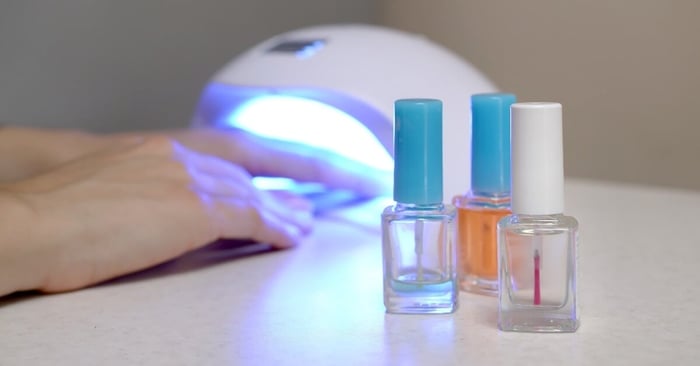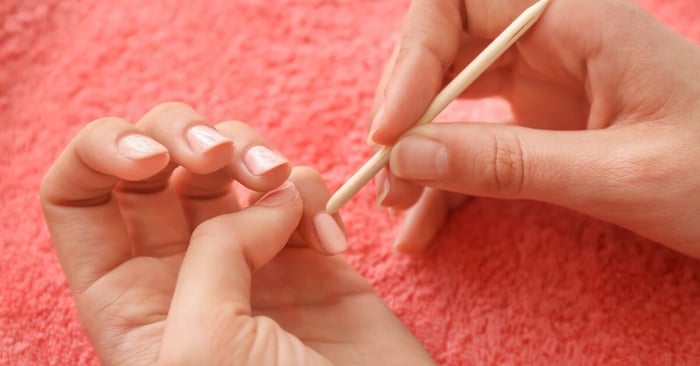Discovering the world of gels can be a game-changer for anyone who loves long-lasting manicures. Gels come in a variety of types, each designed for different nail needs. Ultimately, though, each of the different types of gels will strengthen and support natural nails for beautiful results.
From soft gels that provide flexibility to hard gels that build structure to gel polishes that provide a long-wearing, chip-resistant finish, there’s one to suit every individual. Knowing the differences between the gels will help you select the right formula for your nails and achieve the personalized results you’re looking for.
What Sets Gels Apart
Unlike traditional nail polish, which dries through air exposure, gel formulas require light activation to achieve their signature strength and longevity. Gels contain specialized polymers that cure under a UV or LED light to create a hard finish. This curing process transforms the viscous gel into a durable coating that protects the natural nail. When applied correctly, it can resist chipping and peeling for weeks.
The molecular structure of gels creates stronger bonds between layers, resulting in enhanced adhesion and flexibility. These characteristics make gels ideal for people who want long-lasting manicures without frequent touch-ups. The curing process also eliminates concerns about smudging or denting freshly painted nails.

Types of Gels
Hard Gel
Hard gel creates the most durable and rigid finish among all the types of gels. This formula contains higher concentrations of cross-linking oligomers, which—when cured under an LED or UV light—form powerful bonds that solvents can’t penetrate. Hard gels are strong yet flexible (even more so than acrylic); odorless (a plus for those who are sensitive to acrylic smells); and self-leveling, which can make it easier for those new to working with sculpting enhancements.
Hard gels are predominantly used to overlay the natural nail for added strength and for creating nail extensions, either through sculpting on a form or overlaying a tip. Due to its strength and durability, a set of hard gels will easily last three to four weeks, at which point it will need to be filled or rebalanced. This is the process of filing down some of the old product and reapplying new product for a fresh set. Because of the nonporous formulation, hard gels can be removed only by filing; therefore, this service typically requires a certain level of commitment for maintenance and upkeep.
Soft Gel
Soft gels are a category of gels that offers flexibility thanks to plasticizers, which keep the gel somewhat flexible and give nails a natural look. Soft gels work best for overlay applications on natural nails without adding excessive bulk or weight, as they generally can’t be used to create very long extensions. And as with any other gel, the LED or UV light-curing creates added strength for a long-wear, chip-free manicure.
The removal process for soft gels involves soaking the nails in acetone, making soft gels more convenient for regular maintenance. Some of the more viscous types of soft gels can also be filled, which can be a better option for maintaining the health of natural nails if the soft gels are worn regularly. Repeated soaking and removal can be rough on the natural nail and, if not done properly, can cause damage to the nail plate.
There are a number of different types within the soft gel category, including gel polish, builder gel, rubber gel, treatment gel, tinted builder gel, and more. Each soft gel has different properties and benefits, depending on your nail needs.
Gel Polish
Gel polishes come in countless shades to suit every style preference and occasion. These formulas are thin like traditional nail lacquer, but they must be cured under and LED or UV light in order to achieve that two to three weeks of lasting, chip-free, high-shine color. Gel polishes can be worn on the fingers as well as the toes, and they’re great options for those who struggle with chipping nail polish or who simply want a lasting look.
Specialty color gels may feature magnetic formulas that create unique patterns; thermal polishes that change with temperature; or holographic options that produce stunning light effects. These innovative formulas allow nail artists to create complex designs and eye-catching effects. Most gel polishes come in bottles with brushes, like traditional nail polish, although some do come in pots and must be applied with a separate gel brush. Gel polish systems require thorough nail prep followed by a gel base coat, and they must be finished with a gel top coat. You cannot mix traditional nail polish base and top coats with gel polish.
Rubber Base Gel
Rubber gels have revolutionized the nail industry by providing exceptional adhesion and flexibility for those with weak or damaged nails. These specialized builder gel formulas are more flexible than traditional builder gels, adding strength to nails that need it while moving with the natural nail instead of cracking or lifting. Professional gel nail polish systems often include rubber base options to use for clients with weak nail plates or adhesion issues.
The unique composition of rubber base gels allows you to smooth minor nail imperfections while creating an ideal surface for color application. Additionally, many rubber gels come in neutral tints to match different skin tones, so they can be worn alone for a natural look or as the base to a gel polish manicure by improving overall system adhesion.
Builder Gel in a Bottle
Builder gels that come in a bottle with a brush, similar to gel polish, serve a dual purpose by providing both strength and some length for natural nails. These thicker formulas allow nail technicians to sculpt and shape extensions. However, these gels are meant only to extend the natural nail to a wearable length; they’re not strong enough for long extensions. Builder gels in a bottle cure to create strong, lightweight nails that look natural and that are extremely wearable.
The self-leveling properties of builder gels in a bottle create smooth surfaces without extensive filing or buffing. They’re excellent options for repairing broken nails, filling in chips, or creating extra length on very short or bitten nails.
Treatment Gel
Treatment gels are designed to not only make nails look polished, but also support and protect natural nails. Many are enriched with strengthening ingredients such as keratin and vitamin E, which nourish the nail plate, or are reinforced with nylon fibers and fiberglass for added durability. These formulas are especially useful for weak, thin, or damaged nails that need extra help while they grow out. Treatment gels can also provide a solution for common issues such as splitting, peeling, or breaks. Fiberglass builder gels, for example, work almost like tiny patches to hold the nail together and prevent further damage.
Because treatment soft gels are flexible, they move with the natural nail rather than causing stress, making them a gentler option for long-term wear. They’re often used as a base layer under color for extra strength, or they can be worn alone for a natural, healthy-looking finish.
Choosing the Right Gel Type
Selecting the appropriate gel polish type depends on individual nail conditions, lifestyle factors, and desired outcomes from manicure services. Clients with strong, healthy nails will do well with a gel polish system for natural flexibility and easy removal. Those with weak or damaged nails who desire a natural look will often benefit from a flexible soft gel base before applying gel polish. However, if you’re looking for long-wear, long extensions and are committed to fills every three-plus weeks, then hard gel applications are likely your best choices.
Consider maintenance schedules when choosing gel polish types, as some formulas require more frequent professional attention than others. Active lifestyles may necessitate harder, more durable gel formulations, while occasional wearers might prefer gentler soft gel options. Professional consultation ensures optimal gel selection for individual needs and expectations.
Professional Application Tips
Successful gel polish applications require proper nail preparation, including cuticle care, surface sanitization, and light buffing for adhesion enhancement. Each gel layer must cure completely under the appropriate light source to achieve maximum durability and performance. Thin, even coats produce better results than thick applications, which may cure unevenly or cause bubbling.
Gel base coats are crucial foundations for gel manicure systems, as they promote adhesion of the gel polish to the natural nail. These preparatory formulas contain bonding agents that grip nail surfaces while providing smooth bases for color application. Proper gel base coat selection and application prevent lifting, chipping, and premature wear.
Specialized gel base coats, such as quick-release gel base coats, make gel polish removal even faster. And rubber and treatment gels can double as base gels to address specific nail concerns, such as ridge-filling for uneven surfaces or strengthening for weak nails. For the best results, overall system performance, and longevity, use the gel base coat that is compatible with your other gel product
Gel top coats provide essential protection and finish for your gel manicure. These formulas create durable surfaces that resist dulling, scratching, and environmental damage throughout extended wear. Gel top coats also seal nail art elements and prevent color bleeding between design components.
As with gel base coats, there are different gel top coat formulas offer varying benefits, from ultra-high shine to subtle matte finishes. Some gel top coats create a sticky inhibition layer upon curing that must be removed with isopropyl alcohol or a gel cleanser at the end of the service. No-wipe gel top coats don’t have an inhibition layer and don’t need to be cleansed after curing, which is beneficial for some types of nail art or those looking to skip an extra step. Similar to gel base coats, it’s best to use a gel top coat that is compatible with the gel manicure product you’re using.
Because UV/LED lights are such an important part of any gel manicure, it’s important to perform regular equipment maintenance and replace bulbs, if necessary, to ensure proper curing and performance reliability.

Maintenance and Removal
Proper maintenance extends gel wear time while preserving natural nail health throughout extended periods. Regular cuticle oil application prevents dryness and cracking around nail edges and keeps the natural nail flexible, while gentle hand care maintains overall appearance. Avoiding harsh chemicals and excessive water exposure preserves the integrity of the different types of gel and prevents premature lifting.
Professional removal techniques also protect natural nails from damage. It’s always best to go to a nail professional to have hard gels removed. Never file into the natural nail, as that will cause damage. When in doubt, leave a thin layer of hard gel on the nail, buff it smooth, and allow it to grow out with your natural nail to avoid any unnecessary damage.
For soft gel removal, start by gently filing the surface of the nail to break the seal of the gel top coat; this will allow acetone to penetrate the layers of gel. Filing down the surface of the gel also reduces its thickness before soaking, minimizing removal time and preventing unnecessary nail stress from pushing product off the nail. Following up with nourishing conditioning treatments restores moisture and flexibility, leaving natural nails healthier, stronger, and ready for your next look.


